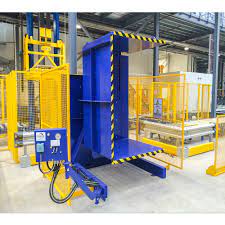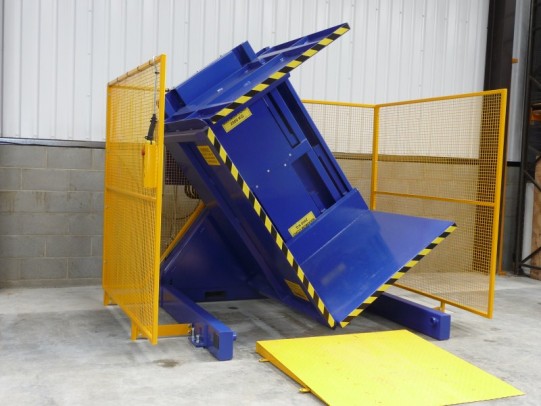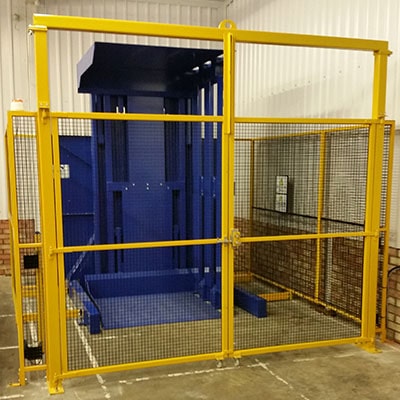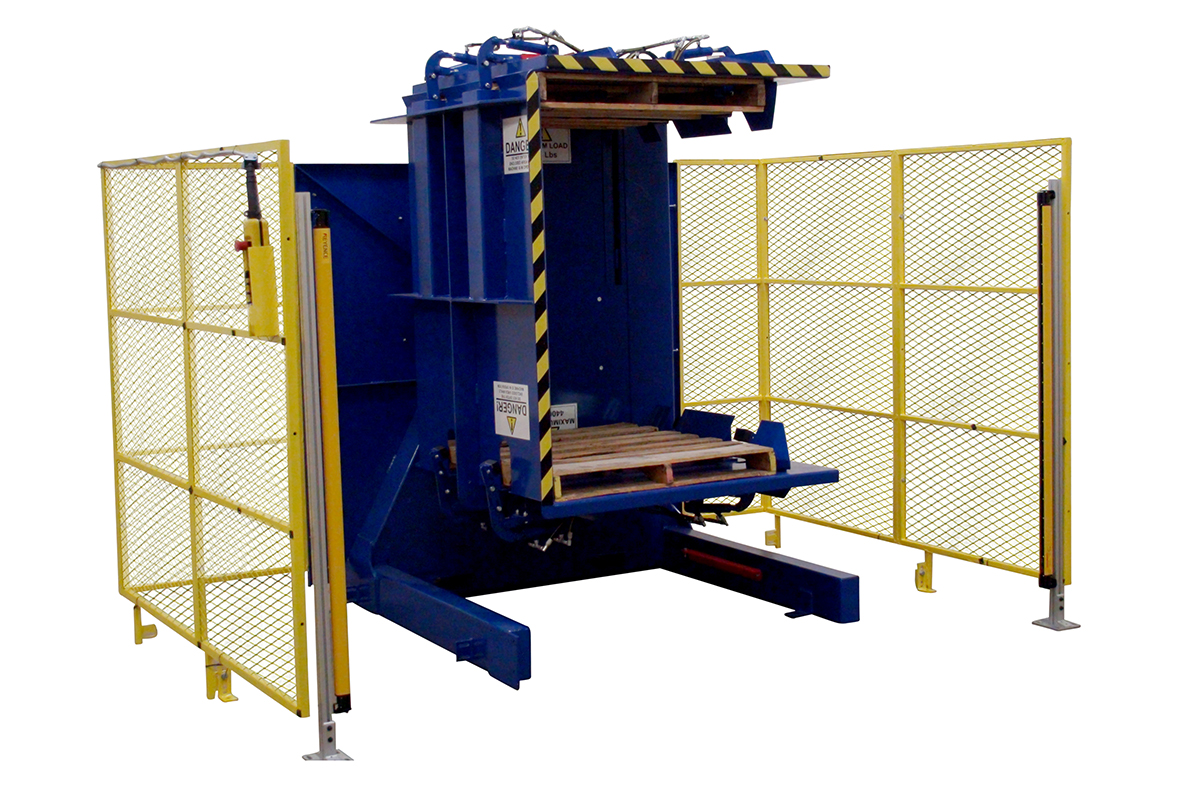Is Your United States Factory Struggling with OSHA Compliance and Labor Cost Reduction? Try a Pallet Changing Machine
Are you constantly worried about workplace injuries in your factory? Do rising labor costs and the difficulty of finding reliable workers keep you up at night? I know the feeling. As a factory owner, you feel trapped between meeting stringent safety regulations like OSHA's and keeping your operations profitable. Every manual task feels like a risk. It's a heavy weight to carry. This constant pressure can make it seem like you're fighting an unwinnable battle, where every dollar saved on efficiency is spent on compliance or compensation claims. But what if you could fundamentally change the equation? Imagine a machine that tackles both safety and cost, a solution that automates the risk right out of your process.
A pallet changing machine, also known as a pallet inverter, is a piece of equipment that automates the process of transferring goods from one pallet to another. For a United States factory, it significantly reduces labor costs by minimizing manual handling and improves OSHA compliance by eliminating the dangerous lifting and bending that are leading causes of workplace injuries. This isn't just a piece of equipment; it's a strategic answer to two of the biggest challenges facing modern manufacturing and logistics operations today. It directly replaces a high-risk, labor-intensive task with a safe, fast, and efficient automated process.

I understand the skepticism. As an engineer who has spent his entire career on the factory floor, I've seen countless "solutions" that promised the world. But a pallet changer is different. It's a simple concept with a profound impact. I've built these machines, I've installed them for clients, and I've seen the results firsthand. It's not just theory; it's about real-world numbers, tangible safety improvements, and a clear return on investment. Let's break down exactly how this machine can transform your factory floor and your bottom line.
How Can a Pallet Changer Directly Address Soaring Labor Costs?
You see the payroll numbers every month. They only seem to go in one direction: up. Finding good, reliable people for physically demanding jobs is getting harder and more expensive. You're paying skilled workers to perform a task that is repetitive, physically draining, and adds no direct value to the products you make. This is a classic operational bottleneck and a huge cost center. It inflates your operating costs and also leads to high employee turnover, constant retraining expenses, and production delays when you are short-staffed. It feels like you're pouring money into a hole with no end in sight. A pallet changer completely flips this script. It turns that cost center into a streamlined, predictable, and highly efficient part of your operation. It’s a one-time capital investment that works to replace ongoing, unpredictable, and ever-increasing labor expenses.
A pallet changer directly addresses soaring labor costs by automating the entire task of transferring loads. This means a single operator, typically a forklift driver who is already on staff, can do the work of several manual laborers in just a fraction of the time. This action dramatically reduces the man-hours required per pallet handled. It frees up your valuable workforce to focus on more skilled, value-adding jobs instead of manual stacking and restacking. The result is a direct, measurable reduction in your payroll expenses for material handling and a more productive team overall.

Dive Deeper: The Real-World Economics of Automation
I spent years on the factory floor before starting my own company. I’ve watched teams of two or three workers spend 15 to 20 minutes manually moving heavy bags or boxes from one pallet to another. It was slow, it was tiring, and sometimes, products got dropped and damaged. The whole time, I was thinking like an engineer: there has to be a better way. The cost of this process is much more than just wages.
Let’s look at a simple comparison. This is the reality I have seen in hundreds of factories.
Manual vs. Automated Pallet Handling: A Head-to-Head Comparison
| Metric | Manual Handling | Automated Pallet Changer |
|---|---|---|
| Workers Required | 2-3 laborers | 1 forklift operator (part-time) |
| Time per Pallet | 15-20 minutes | < 2 minutes |
| Pallets per Hour | 3-4 | 30+ |
| Cost per Pallet (Labor) | High and variable | Extremely low and fixed |
| Risk of Product Damage | Moderate to High | Very Low |
| Risk of Worker Injury | High | Near-Zero |
The numbers in the table tell a powerful story. But the savings go even deeper. Think about the hidden costs of manual labor. You have recruitment costs to find new workers. You have training costs to teach them how to do the job safely. You have higher insurance and workers' compensation premiums because the job is inherently risky. You pay overtime when you are busy or short-staffed. And you lose productivity when a worker is absent.
A pallet changing machine eliminates most of these costs. It's a reliable piece of your team that shows up to work every single day. It doesn't get tired, it doesn't ask for a raise, and it performs the task perfectly every time. For a business owner trying to lower overall operating costs, automating a process like this is one of the most direct and effective actions you can take. It’s a clear path to higher efficiency and a stronger bottom line.
Can Automated Pallet Inverters Really Improve OSHA Compliance?
Every factory owner in the United States knows the feeling. The thought of a call from OSHA or an unannounced inspection can cause a lot of stress. The regulations are complex, the potential for fines is significant, and the entire process is a major disruption to your business. You know that manual material handling is a major focus for safety inspectors. Back injuries and muscle strains from lifting, bending, and twisting are among the most common and most expensive workplace incidents. Each injury is a personal tragedy for the employee, but it's also a financial liability for your company that can damage your reputation and increase your insurance rates.
Yes, automated pallet inverters dramatically improve OSHA compliance because they are an engineered solution. They are specifically designed to eliminate the risks that OSHA targets. By automating the process, you remove the human element from the most dangerous parts of the job. It's about designing the hazard out of the process entirely. This makes compliance a built-in feature of your operation, not something you have to constantly police and worry about. It creates a fundamentally safer work environment from day one.

Dive Deeper: Moving from Reactive to Proactive Safety
OSHA's entire philosophy is built on something called the "Hierarchy of Controls." The most effective way to control a hazard is to eliminate it completely. That is exactly what a pallet inverter does. Let's break down the specific risks of manually swapping pallets that an OSHA inspector would look for:
- Hazardous Lifting: Workers lifting heavy boxes or bags, often weighing 50 pounds or more.
- Awkward Bending: Workers bending over to reach the bottom layer of a pallet.
- Repetitive Twisting: Workers twisting their spine to move goods from one pallet to another.
- Struck-by Hazards: The risk of items falling from an unstable, half-finished stack.
A pallet inverter addresses every single one of these. The machine securely clamps the entire load. It rotates the load smoothly and safely. It uses gravity to gently transfer the product to the new pallet. The operator is standing safely inside a forklift or at a control panel, completely removed from the danger zone.
I remember a client in the United States who was struggling with this exact issue. Their workers' compensation premiums were going up every year because of recurring back and shoulder injuries in their shipping department. They felt they were doing everything right with training and procedures, but the injuries kept happening. We installed one of our pallet inverters. In the first year, their injury claims in that department dropped to zero. Their insurance provider even lowered their premium at their next renewal. They stopped reacting to problems and started preventing them.
From a Reactive to a Proactive Safety Culture
| Feature | Reactive Safety (Manual Process) | Proactive Safety (Automated Process) |
|---|---|---|
| Hazard Control | Relies on worker training, PPE, and hoping for the best. | The physical hazard is engineered out of the job. |
| Injury Risk | High and always present. | Almost zero for this specific task. |
| Compliance | Requires constant supervision and documentation. | Compliance is built into the machine's standard operation. |
| Associated Costs | Ongoing costs from injuries, claims, and potential fines. | A one-time capital investment with very low operational risk. |
Investing in a pallet inverter is one of the clearest statements you can make to your employees and to OSHA that you are serious about safety. It shows you are willing to invest in permanent solutions, not just temporary fixes.
What Is the True ROI of a Pallet Changing Machine for a High-Capacity Plant?
As a business owner, I know that every major purchase has to be justified on a spreadsheet. You simply cannot afford to invest in equipment that is just "nice to have." You need machines that work hard and deliver a clear, measurable return on investment (ROI). You have probably been presented with new technology before that promised amazing results but delivered only headaches and a poor return. It's right to be skeptical. The initial price tag for a quality machine can seem high, and it can be difficult to see past that number to the long-term gains.
The true ROI of a pallet changing machine in a high-capacity plant is typically realized within 12 to 24 months. This rapid return is calculated not only from the obvious direct labor savings but also from preventing costly product damage during transfer, increasing the overall speed of your logistics, and completely eliminating the significant financial risks associated with workplace injuries and OSHA fines. When you look at the full picture, the investment becomes one of the smartest financial decisions a factory can make.

Dive Deeper: Building the Framework for Your ROI Analysis
I approach every machine purchase with the same rigorous analysis. Let's build a simple framework you can use to calculate the ROI for your own factory. The calculation has two main parts: the Return and the Investment.
1. Calculating the "Return" (Your Annual Savings)
- Direct Labor Savings: This is the easiest to calculate. Take the number of workers you no longer need for this task. Multiply their fully-loaded hourly wage (including benefits and taxes) by the hours they spent on this task each year. This number alone is often substantial.
- Injury Prevention Savings: This is a big one. According to the National Safety Council, the average cost of a medically consulted workplace injury is over $40,000. If you prevent just one serious back injury, the machine has already paid for a large portion of itself.
- Product Damage Reduction: Manually handling goods always leads to some level of damage. Estimate the value of products damaged or destroyed during manual pallet swapping each year. A pallet inverter handles loads gently and securely, reducing this number to near zero.
- Pallet Cost Savings: Many companies use expensive pooled or rental pallets (like CHEP or PECO) for shipping. For internal storage, you can use much cheaper in-house pallets. A pallet changer allows you to quickly and easily switch from an expensive shipping pallet to a cheap internal pallet, creating significant savings.
2. Calculating the "Investment" (Your One-Time Costs)
- Machine Purchase Price: The upfront cost of the pallet changer.
- Installation & Training: The cost to set up the machine and train your operators.
- Annual Maintenance: A small annual budget for preventative maintenance, parts, and service.
Let’s imagine a scenario for a high-capacity plant. Suppose you need to swap 40 pallets per day. Manually, this is a full-time job for at least two people. With a pallet changer, it becomes a small part of one forklift operator's day. The labor savings alone could be over $100,000 per year. Add in the savings from preventing damage and injuries, and you can clearly see a payback period of well under two years. This isn't an expense; it's an investment in profitability and stability.
How Do Pallet Changers Integrate with a Digitized Factory?
You are building a "smart factory." You're investing in a Manufacturing Execution System (MES), deploying IoT sensors, and using data to make smarter decisions. You want total visibility into your operation. But then you look at your shipping dock, and you see a process that is completely manual and disconnected. A manual pallet swap is a black hole in your data stream. You don't know exactly how long it took, who did it, or if any product was damaged. It's an analog process in a digital world, and it breaks the chain of information that you are working so hard to build.
Modern pallet changers are designed to integrate seamlessly into a digitized factory. They are not just mechanical devices; they are data-rich nodes in your digital ecosystem. They come equipped with PLCs (Programmable Logic Controllers) that can connect directly to your MES or WMS (Warehouse Management System). By using sensors and communication modules, they can report vital information like cycle times, pallet counts, operational status, and fault diagnostics in real-time. This turns a simple logistical task into a valuable source of operational intelligence.

Dive Deeper: Transforming Mechanical Action into Digital Information
When we design a machine at SHJLPACK, we think about data just as much as we think about steel and motors. The "brain" of a modern pallet changer is its PLC. This is the same industrial computer that runs your most critical production lines. It speaks the same language as the rest of your factory. This is crucial because it allows the pallet changer to become an active participant in your smart factory.
Here are some of the key data points a connected pallet changer can provide to your central systems:
- Cycle Time: A precise timestamp for the start and end of every cycle.
- Pallet Count: An accurate count of pallets processed per shift, day, or week.
- Machine Status: Real-time information on whether the machine is running, idle, or has a fault.
- Fault Diagnostics: Specific error codes sent directly to the maintenance team for fast troubleshooting.
- Operator ID: Integration with a badge scanner can log which operator used the machine.
This data is not just for records. It is actionable intelligence that helps you achieve your highest-level goals.
The Pallet Changer's Role in a Smart Factory Ecosystem
| Pallet Changer Data Stream | Impact on Your Factory Goals |
|---|---|
| Cycle Times & Counts | Feeds directly into your MES to calculate Overall Equipment Effectiveness (OEE) and track real-time throughput. |
| Fault Diagnostics & Alerts | Enables a predictive maintenance strategy. The system can alert your team before a small issue becomes a major breakdown. |
| Real-time Status | Provides complete production visualization. You can see the status of your logistics area on your factory-wide dashboards. |
| Integration with WMS | Automates inventory tracking. When a load is swapped, the system can automatically update the pallet ID in your warehouse system. |
Being a "Total Solution" provider, for me, means understanding your bigger picture. It's about delivering a machine that not only solves a physical problem but also supports your digital transformation strategy. We don't just sell you a machine; we provide a tool that helps you run your entire business better.
Conclusion
A pallet changer is more than a machine; it's a strategic tool for cost reduction, safety compliance, and digital integration. It solves today's problems and prepares your factory for tomorrow.




